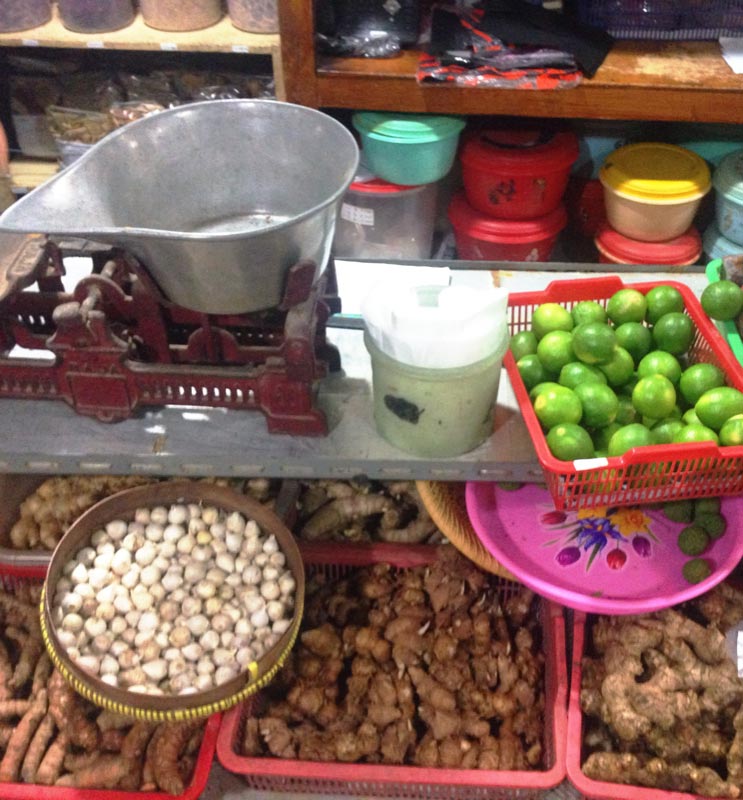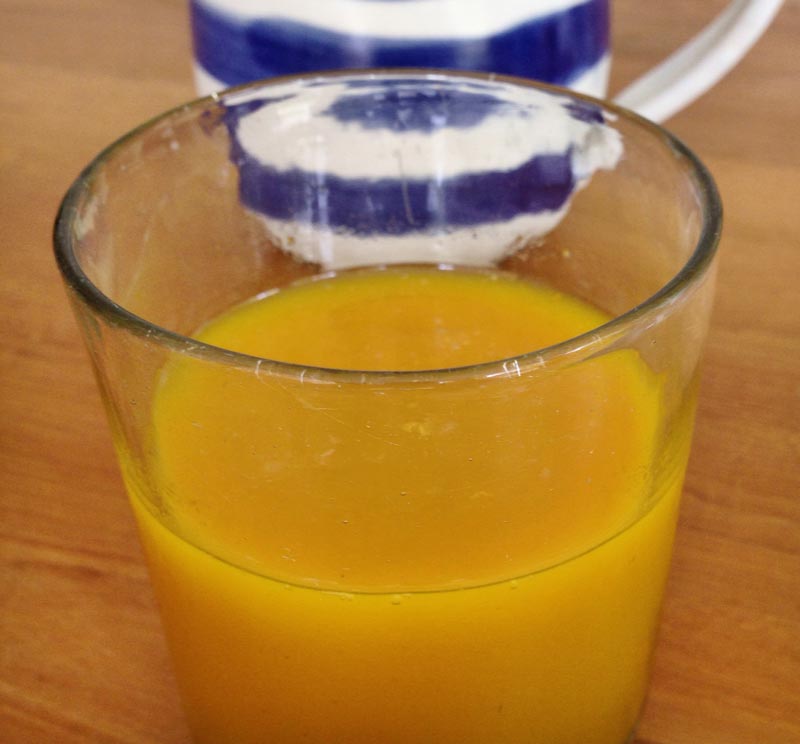An Introduction to Jamu - and How To Make Jamu Kunyit Asam
Jamu is the name for traditional herbal therapy in Indonesia and most typically involves the consumption of tonics, expertly prepared by Jamu ladies using traditional ingredients sourced from nature. The World Health Organisation estimates that approximately 70% of all Indonesians use Jamu on a daily basis to enhance their health, treat a myriad of complaints and to prevent the onset of others.
Every morning throughout the neighbourhoods of Jakarta, women can be seen carrying baskets on their backs or riding bikes with baskets containing bottles filled with various concoctions. The contents of these bottles is called tukang jamu, or 'artisan herbs'. These women are known as Jamu Gendong (which translates as 'carrying on the back'). As is traditional, Jamu Gendong cover their route with precision timing, calling 'Jamu' as they go. Their customers emerge from houses, from behind kaki-lima (food carts) or seemingly out of nowhere to receive their daily tonic. This transaction normally involves some friendly banter and conversation regarding health issues, assisting the Jamu lady to select and prepare the most appropriate recipe for the customer.
Ibu Kasimen is a traditional Jamu Gendong. She provides jamu to residents of South Jakarta
Tukang Jamu
Theory of Jamu prescription
Traditional Indonesian healers define health as a balance between the extremes of hot and cold, and dry and wet. If one's body becomes too hot, for example during time of fever, cooling vegetables and herbs are prescribed. In contrast, spices are used when the body needs warming, as is the case when one is experiencing a cold.
An experienced Jamu practitioner will be able to prescribe a remedy for just about any ailment or complaint; from skin problems to sexual dysfunction, stress-related issues to gastric distress. It seems that mixing the right ingredients in the correct quantities has the potential to resolve many concerns.
What are the traditional ingredients of Jamu?
The dense and abundant tropical forests of Java provided the original healers with a diverse range of ingredients such as local indigenous flowers, leaves, roots and barks. Ginger, Javanese turmeric, tamarind, galangal and cardamom, are the most popular ingredients in Jamu. The use of beras (uncooked rice) features in some recipes and occasionally some recipes call for the use of animal material such as goat's bile.
Some of the traditional ingredients used in jamu including tumeric, ginger, kaempferia galanga and jeruk nipis
When and where did Jamu originate?
General consensus suggests that Jamu originated in the Mataram Kingdom some 1300 years ago. The Mataram (or Medang Kingdom) was a Javanese Hindu–Buddhist kingdom which existed between the 8th and 10th Centuries. The Mataram Kingdom was originally based in Central Java and later extended into parts of East Java.
Different regions of the Indonesian archipelago use different Jamu recipes, which are seldom written down, instead passed down my word of mouth from generation to generation.
Our Jamu experience
Upon arriving in Jakarta in late 2013, I became curious about Jamu. I noticed it being sold in its various forms from the bespoke tonic to the mass-produced product in the form of tablets, lozenges and sachets. Holding the belief that 'fresh is best' I acquired a recipe for one type of Jamu and then provided our neighbourhood mobile grocer, Ibu Norhayati, with my Jamu shopping list (see her profile in our People section). Ibu Norhayarti returned the following day bearing all the necessary ingredients to prepare Jamu Kunyit Asam. This is a traditional Jamu recipe known for its benefits of cleaning the blood, removing body odour, improving circulation and reducing pain during menstruation. Together with my lovely pembantu, Ibu Tuti, we prepared our raw ingredients and set to work making my first brew of Jamu. Here is the recipe.
Unpeeled ingredients for Jamu Kunyit Asam (excluding the cinnamon quills)
Recipe for Jamu Kunyit Asam
Ingredients
(Enough for 7+ mornings)
1 L fresh water (900ml cold, 100ml hot)
150g turmeric
20g kaempferia galanga/kencur
20g curcuma zedoaria/white turmeric
100g tamarind paste (dissolve this in some hot water)
50 - 100g palm sugar (adjust to taste)
Small pinch of salt
2 - 3 large bottles, sterilised
Method
Remove all skin from the fresh roots and wash thoroughly in fresh water
Chop into small pieces and place in blender (Do this step in batches to keep the volume manageable)
Blend until a smooth consistency is achieved (Add a little fresh water to create a paste). Continue until all the root ingredients have been processed. Set aside
Into a cup add the tamarind paste. Dissolve the paste in a few tablespoons of boiling water. If the paste still contains the tamarind seeds, strain the solution to separate out the seeds. Keep the liquid and set aside
Into a large bowl pour 100ml hot water. Add the palm sugar and salt, stirring to dissolve. Add the remaining 900ml of water as well as the tamarind solution. Stir to mix thoroughly
Add the root mixture from blender to liquid mixture from previous step, mixing well
Using a large, fine sieve, strain the mixture to separate out the liquid from the pulpy solid, collecting the liquid in a bowl. The use of the back of a large spoon to squeeze out all the liquid will speed up this process
Using a funnel, pour the Jamu liquid into sterilised bottles
Drink a small glass-full each morning
Benefits of Jamu Kunyit Asam:
This is a traditional Jamu recipe known for its properties of blood cleansing, removal of body odour, improvement of circulation and reduction of pain during menstruation.
The tumeric is an anti-inflammatory and also contains high levels of anti-oxidants. The tamarind is known to ease stomach discomfort and aid digestion.
A glass a day will give you a great boost of antioxidants
Note: Over the next seven days I enjoyed a small glass of Jamu each morning and it has now become a regular part of my daily routine. As to whether I feel any different.. It's too early to tell but I can tell you one thing; I did experience a physical change. On my first day of Jamu-ing (?), I left the house with a bright orange ring around my mouth and fortunately noticed it before I greeted anyone. Be warned!
Words: Jo Stevens Photography: a journey bespoke









